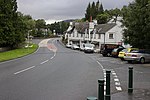Brockhole

The Brockhole Lake District Visitor Centre, also known as the Brockhole National Park Visitor Centre, is a visitor centre and tourist attraction managed by the Lake District National Park Authority. It is situated on the shore of Lake Windermere, roughly equidistant between the towns of Bowness-on-Windermere and Ambleside. It includes the Brockhole house and 30 acres (12 ha) of grounds, including 10 acres (4.0 ha) of formal gardens and an adventure playground. The centre organises a number of activities, including orienteering, kayaking and open water swimming, as well as regular exhibitions.Entrance to the centre and its grounds is free of charge, although a charge is made for car parking.
Excerpt from the Wikipedia article Brockhole (License: CC BY-SA 3.0, Authors, Images).Brockhole
South Lakeland Lakes
Geographical coordinates (GPS) Address Website External links Nearby Places Show on map
Geographical coordinates (GPS)
| Latitude | Longitude |
|---|---|
| N 54.401026 ° | E -2.942883 ° |
Address
Brockhole on Windermere
LA23 1LJ South Lakeland, Lakes
England, United Kingdom
Open on Google Maps








